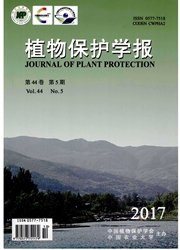

 中文摘要:
中文摘要:
为明确群体感应系统在枯草芽胞杆菌NCD-2菌株抑菌活性和生物膜形成中的作用,通过同源重组技术对群体感应系统中的comA基因进行定位缺失突变,分别比较了NCD-2菌株和comA基因突变子在胞外酶合成、抑菌活性、脂肽抗生素(丰产素)产生以及生物膜形成上的差异,并进一步利用实时荧光定量RT-PCR技术比较了二者生物膜基质编码基因epsA和tasA的表达情况。结果表明,通过同源重组技术获得了comA基因突变子MA-4,同菌株NCD-2相比,其在胞外蛋白酶和纤维素酶的合成能力、对番茄灰霉菌Botrytis cinerea的抑菌活性、丰产素的合成量和生物膜的形成能力上均明显下降;生物膜基质编码基因tasA的表达量下降了70%,而epsA的表达量变化不明显。表明ComA是NCD-2菌株脂肽抗生素和生物膜形成中的重要调控因子。
 英文摘要:
英文摘要:
To understand the effect of the comA gene on antifungal activity and biofilm formation in Bacillus subtilis NCD-2,a comA in-frame deletion mutant strain were constructed by homologous recombination,and the activities of its extracellular enzymes,antifungal activity,lipopeptide(fengycin)production and biofilm formation were evaluated in comparison with the wild-type strain NCD-2.Expressions of biofilm-associated genes eps A and tasA were analyzed by using reverse transcription quantitative real-time polymerase chain reaction(RT-qPCR).The results showed that the comA deletion mutant MA-4 led to a less production of protease,cellulase and fengycin,reduced the biofilm formation and inhibited mycelial growth of Botrytis cinerea.RT-qPCR analysis revealed a 70% decrease of the expression of the tasA gene in the comA null-mutant,but the eps A gene was not affected by the deletion of comA.The results suggested that ComA is an important regulatory factor on fengycin production and biofilm formation in B.subtilis strain NCD-2.
 同期刊论文项目
同期刊论文项目
 同项目期刊论文
同项目期刊论文
 期刊信息
期刊信息
